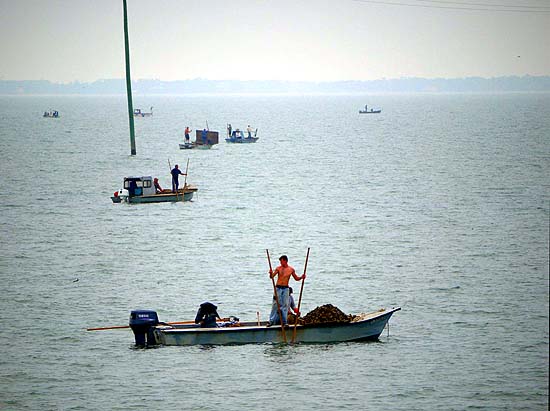 I met Kendall Schoelles around dawn at 14.2 miles west of the John Gorrie Memorial Bridge on Route 30A. (That’s how they measure distances in Apalachicola, Florida.) We drove his pickup down a packed dirt path to a marshland dock, where we boarded Schoelles’ shallow-draft oyster boat. We were headed for the oystering grant that’s been in his family since the late 19th century. The Schoelles family grant used to be 1,100 acres; after government takings, it’s down to 158. That’s enough to keep Kendall and his brother harvesting enough oysters to make a living. Most Apalachicola oystermen, like those pictured above, have to make do with the public bars.
I met Kendall Schoelles around dawn at 14.2 miles west of the John Gorrie Memorial Bridge on Route 30A. (That’s how they measure distances in Apalachicola, Florida.) We drove his pickup down a packed dirt path to a marshland dock, where we boarded Schoelles’ shallow-draft oyster boat. We were headed for the oystering grant that’s been in his family since the late 19th century. The Schoelles family grant used to be 1,100 acres; after government takings, it’s down to 158. That’s enough to keep Kendall and his brother harvesting enough oysters to make a living. Most Apalachicola oystermen, like those pictured above, have to make do with the public bars.
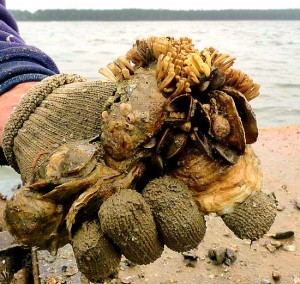 Apalachicola Bay oysters are the pride of the Gulf of Mexico – plump, sweet, and salty. It’s the last place in North America where wild oysters are harvested by hand by oystermen in small wooden boats. It’s back-breaking work, not unlike the small-boat lobstering I used to do in Maine, and I felt honored that Schoelles let me come along to participate, if only peripherally, in this vanishing way of life. Food doesn’t get any more locavore than shellfish from a town’s front-yard bay.
Apalachicola Bay oysters are the pride of the Gulf of Mexico – plump, sweet, and salty. It’s the last place in North America where wild oysters are harvested by hand by oystermen in small wooden boats. It’s back-breaking work, not unlike the small-boat lobstering I used to do in Maine, and I felt honored that Schoelles let me come along to participate, if only peripherally, in this vanishing way of life. Food doesn’t get any more locavore than shellfish from a town’s front-yard bay.
Apalachicola Bay is a unique environment on the Gulf of Mexico, created by an extensive barrier island system at the mouth of the Apalachicola River, which drains much of Georgia and the Florida panhandle. The plankton-rich mix of salt and fresh water creates optimal conditions for oysters. Apalachicola bivalves have always been the premium Gulf Coast oysters, so prized that oysters from elsewhere in the Gulf were sent here for packing so they would be shipped out in crates stamped ”Apalachicola.”
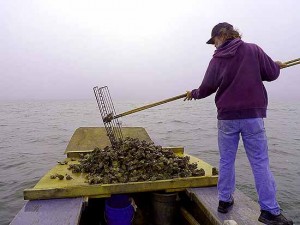 Schoelles revved the engine and we sped through the weeds into flatwater, unable to see more than a few feet in the fog. I asked how he found his lease under such conditions. ”Mostly, I just know,” he told me. ”I’ve been coming here most of my life.” Schoelles has never fished more than two months anywhere else but on his lease. He paused for effect, ”Of course, the last four or five years I use GPS.”
Schoelles revved the engine and we sped through the weeds into flatwater, unable to see more than a few feet in the fog. I asked how he found his lease under such conditions. ”Mostly, I just know,” he told me. ”I’ve been coming here most of my life.” Schoelles has never fished more than two months anywhere else but on his lease. He paused for effect, ”Of course, the last four or five years I use GPS.”
We anchored on a bar and Schoelles got down his tongs, which resemble two garden rakes connected together like a pair of scissors. The fog was starting to lift, and I could see that loons ringed the boat because tonging stirs up the small fish that they like to eat. The chicks were diving feet from the gunwales while the adults kept their distance. Both herring and laughing gulls had keen eyes on the boat.
Tonging is intensely hard work – reaching down to the bars, closing the rakes, and hauling the catch to the surface. Schoelles did it methodically, moving the boat a few feet every few minutes, until we had a huge heap of oysters and other sea life on the deck. With the sun trying to peek through the fog behind him, he seemed to glow beatifically.
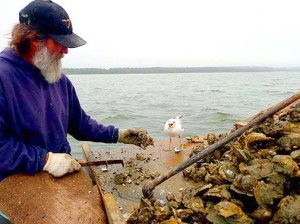 Then we sat down for the grunt work. Because Apalachicola Bay oysters are wild, not farmed, they grow in clumps with a slew of other organisms – mussels, clams, sea cucumbers, giant algae, and other creatures I couldn’t possibly name. The oysters have to be separated from all these other objects – mostly by banging on the junctions with a steel culling iron without cracking the shell. All the small oysters must be tossed back to grow. Schoelles held out whelks and starfish to take ashore to die because both are oyster predators.
Then we sat down for the grunt work. Because Apalachicola Bay oysters are wild, not farmed, they grow in clumps with a slew of other organisms – mussels, clams, sea cucumbers, giant algae, and other creatures I couldn’t possibly name. The oysters have to be separated from all these other objects – mostly by banging on the junctions with a steel culling iron without cracking the shell. All the small oysters must be tossed back to grow. Schoelles held out whelks and starfish to take ashore to die because both are oyster predators.
The cracked oysters (it’s easy to smash a shell by accident) became bird food for the gulls that follow the boat. One laughing gull has been coming to Schoelles’ boat every morning for two years. How does he know it’s the same gull? He doesn’t – not for sure – but the two seem to have an understanding. 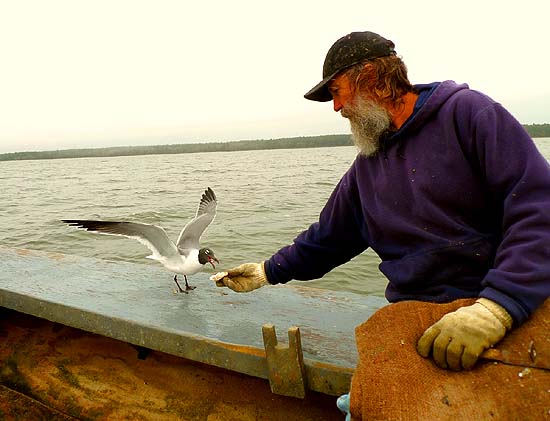
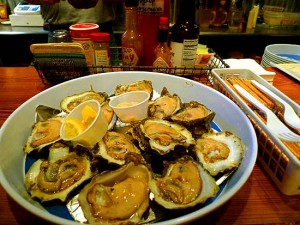 The birds of Apalachicola eat well – but then so do the people. For more on where to enjoy the nutty, buttery flavor of Apalachicola Bay oysters, see my profile of three restaurants in the October 28 Boston Globe: “Where to eat oysters in Apalachicola.”
The birds of Apalachicola eat well – but then so do the people. For more on where to enjoy the nutty, buttery flavor of Apalachicola Bay oysters, see my profile of three restaurants in the October 28 Boston Globe: “Where to eat oysters in Apalachicola.”
